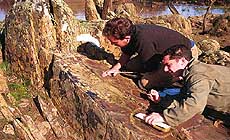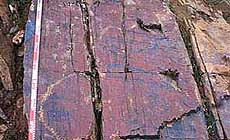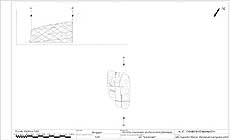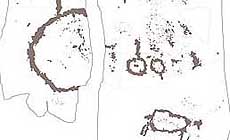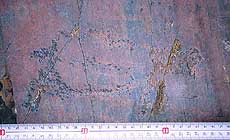|
|
 |
 |
Country: |
España |
Locality: |
Alconchel |
|
 |
Region: |
Extremadura |
Area: |
Molino de Manzánez |
|
 |
 |
|
|
|
|
| |
 |
Environment & Surface |
 |
 |
 |
|
Altitude:
|
118 m
Open-air
Shelter
Cave
Portable
Megalithic
|
Geography: |
Carving zone of Cheles is located between Molino Manzanez area (Manzanez Mill) to Friegamuñoz Stream through the left bank of the river Guadiana. This area is affected by seasonal floodings of the river. Characteristic vegetation is mediterranean meadow. Traditional use of the land it's been the shepherding, the hunt and the fishing. |
Proximity: |
We arrive to the riverside where the engravings are located throught a path who runs 4 kms. from Cheles -which is the nearest locality to the rupestrian group- to the Guadiana. In the riverside we find a mill named " Molino de Manzánez" which is a common public area. About 1 km. Far from the mill to the South, ther is located this rock with engravings wich is only 5 meters far from the river course. |
|
 |
Geology: |
Methamorphic slate. |
Surface: |
It is an inclined surface that shows an orientation of 320º N. A great crack that divides the surface in two parts all over red and black coloured. There were lichens covering it all and some areas worn away. |
|
Dimensions:
|
Length 1.67 m.
Width 0.80 m.
|
|
 |
 |
|
|
|
|
| |
 |
Art |
 |
 |
 |
Description: |
Engravings
Paintings
Painted engravings
High or low-relief
Sculpture
Mainly the panel presents the percussion technique but there are also some lines carried out with the incision technique. The rock is divided by means of a great crack that is 1'34 m. of long and 5-6 cm. wide. Up, in the superior part we can see a group of lines carried out in incision whose dimensions oscillate between 0'5 and 7 cm. long and they are willing of inclined way and vertical. Among them there is a vertical bar made with percussion, and it measures 5 long cm. and 1 wide cm.. Under there are pecked remains that form two vertical bars that measure 13 and 9 cm. long and 1 cm. wide respectively. Some loose bows of percussion with no defined shape are sourrounding these figures. Below these bars there is a big ideomorph, kind of square (whose sides measure 8 cm. long each one), that is vertically joint to a partial circle affected by the great crack mentioned previously. This " semicircle " has a diameter that is of 31 cm. long. The joint of these two motives is carried out by means of a line pecked and it measures 9 cm. long. Inside the circle and to the side, there are pecked remains. To the left there are a small bar 3 cm. long and 1 cm. wide. To the right of the great crack that divides the rock, in the superior part, there are a curved long pecked line that it descends along 74 cm. and that it is broken in some parts because of another crack. The thickness is very irregular but it usually measures 1 cm. In the superior part there are also 9 horizontal lines carried out with incision whose dimensions oscillate between 1 and 14 cm. long. There is also a kind of bar that meassures 7 cm. long and 2 cm. wide. Below, there are loose bows. In the central part there is an oval traced with a willing line whose diameter major measures 16 cm. long and the minor it is 10 cm. long. This oval has a willing appendix of vertical way that meassures 20 cm. of long. Inside of there are more peckeds remains and in the inferior part it has two appendixes respectively more than 7 and 2 cm. To the right of this oval there are more pecked remains and two groups of incise lines. Next below, besides pecked remains and loose blows, two circles whose diameters measure 5 and 4 cm. long respectively. The first one has a vertical appendix in the superior part (7 cm. long) and it also has a small spot in the central part. The other circle has a vertical line in the inferior part that measures 3 cm. long. Located in the inferior part of the panel there is a quadruped animal. It is a schematic figure. The body is an oval whose major diameter measures 12 cm. long and the minor one it measures 7 cm. long. It is possible to differentiate the tail (2 cm. long); the head (3 cm. wide and 4 cm. of high) and the legs that are 5 cm. long. The animal is 11 cm. tall. Arround it and also in the inside there are some blows, made by means of the percussion.
|
Figures: |
total number 8
Incision lines, bars, 3 circles, semicircle, zoomorphic.
|
|
 |
Chronology: |
Palaeolithic
Epipalaeolithic - Mesolithic
Neolithic
Copper Age
Bronze Age
Iron Age
Roman
Middle Age
Modern
Unknown
EPIPALEOLITHIC (IX millenium b.C) // NEOLITHIC (IV-III millenia b.C.) // COPPER AGE ( II milenium b. C.)
|
Notes: |
EUROPREART DB Cheles records are just a little sample in short of the hole documentation of the site. All the documentation is registered in our own DB, and you can ask for more information at the e.mail adress barbaon@terra.com. |
|
 |
 |
|
| |
 |
Bibliography |
 |
|
|
|
|
| |
 |
Conservation |
 |
 |
 |
Status: |
Public
Private
Park
Classified site
|
Risk: |
The principal risk that run the engravings are the future inundation of the area due to the constrution of the portuguese dam of Alqueva. |
|
 |
Conservation: |
Good
Quite good
Mediocre
Bad
|
Intervention: |
Guadiana Valley carvings have had three campaigns of field work along year 2001 -5 months- for the whole documentation of the 573 rocks found in the site. All records are now in proccess of study for at least 4 months, that will come to a joint exhaustive publication with the ones recorded in portuguese river side. There are also incoming works consisting in the reproduction of a number of rocks in plastic materials for forecoming studies and real reproduction if posible in the future. |
|
 |
 |
|
|
 |
By |
 |
|
| |
| Record n. 128 / 807 |
No commercial use is allowed. Specific © is mentioned in the captions or owned by each Author or Institution |
|
| |
 |
EuroPreArt, European Prehistoric Art, is a web-based archaeological project funded by the European Union which aims to establish a lasting data-base of European prehistoric art documentation, to launch the base of an European institutional network and to contribute to the awareness of the diversity and richness of European Prehistoric Art.
It is proposed by: Instituto Politécnico de Tomar (IPT, Portugal),
CUEBC - European University Centre for Cultural Heritage (Italy - Europe),
Consejo Superior de Investigaciones Científicas (España),
Asociación Cultural Colectivo Barbaón (España),
Université de Liège (Belgique),
Gotland University College (Sverige),
University College Dublin (Eire),
Cooperativa Archeologica Le Orme dell'Uomo (Italia),
Study Centre and Museum of Prehistoric Art of
Pinerolo (Italia),
The European Centre for Prehistoric Research in the Alto Ribatejo (Portugal),
ArqueoJovem - a youth NGO (Portugal).
|
|
|
|
 |
|
 NEW: Alpine rock paintings
NEW: Alpine rock paintings